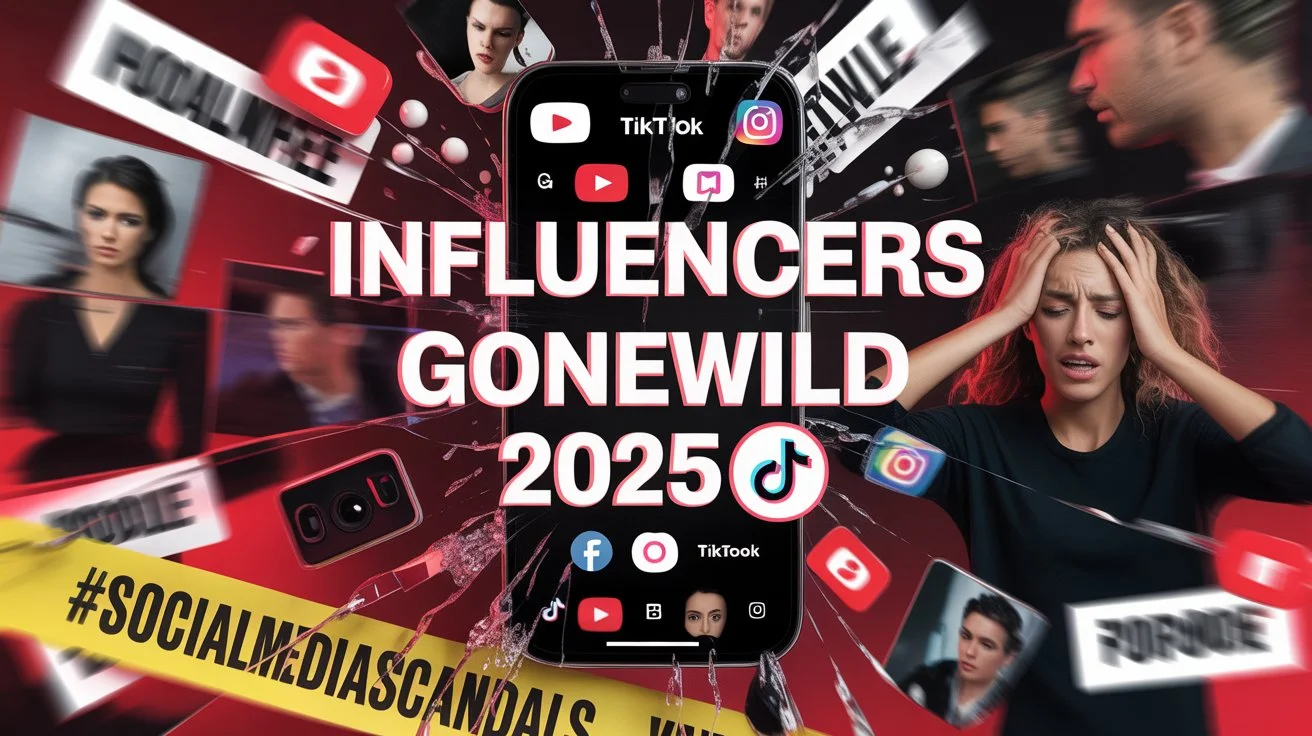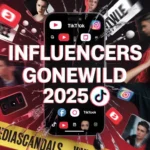Last updated on June 15th, 2025 at 05:58 pm
In 2025, influencers are the new celebrities. With millions of followers, brand deals, and viral fame, they dominate platforms like TikTok, YouTube, and Instagram. But with great reach comes even greater risk.
When content creators cross moral, legal, or ethical lines for clout and clicks, the internet dubs them as “Influencers GoneWild.” This phrase has exploded in popularity as audiences crave drama and digital chaos.
From fake marriages and bathwater sales to platform bans and criminal charges, this article dives deep into the wildest influencer controversies, the psychology behind these actions, and their impact on fans and society.
📈 The Rise of Influencer Culture: How We Got Here
The influencer era began in the 2010s and evolved rapidly by the 2020s. Today, creators don’t just entertain—they influence politics, fashion, finance, and behavior.
- Over $25 billion will be spent on influencer marketing in 2025 alone (Statista).
- 42% of Gen Z admit to imitating influencers they follow.
What makes influencers powerful? It’s authenticity and access—followers feel like they know them. But this relatability also leads to blurred lines between personal lives and public content.
And when virality becomes the currency, many are tempted to trade morals for momentum.
🚨 Why Influencers Go Too Far for Fame in 2025
In the attention economy, nothing spreads faster than scandal. Influencers know:
Controversy = Engagement.
So, they take risks:
- Dangerous stunts
- Offensive content
- Staged drama
- Fake relationships
- Exploiting serious topics for views
👉 Algorithms reward engagement, not ethics. The bigger the shock, the faster the rise—until backlash hits.
⚡️ Viral Disasters: Shocking Influencer Scandals You Need to Know
Here are real-life examples of Influencers GoneWild that made headlines:
| Influencer | Scandal | Fallout |
|---|---|---|
| Logan Paul | Filmed suicide victim in Japan | Global outrage, YouTube penalties, lost deals |
| Jake Paul | Hosted wild parties during lockdown | Legal trouble, platform criticism |
| Belle Delphine | Sold “Gamer Girl Bathwater” | Viral buzz, backlash & praise |
| James Charles | Accused of messaging underage fans | Followers lost, brand partnerships dropped |
| Tana Mongeau | Faked a marriage for views | Accusations of deceit |
| David Dobrik | Unsafe pranks, assault allegations | Demonetized, brand deals ended |
| Lil Tay | Profanity at a young age | Parental investigations, media concern |
Each case reveals how quickly influence turns into infamy.
🧠 The Psychology Behind Going Viral at All Costs
Why do influencers risk everything? The answer lies in:
- Fear of irrelevance
- Addiction to validation
- Lack of real-world consequences
- Blind encouragement from fans
Fame creates a pressure cooker, and without boundaries, creators push further to stay relevant.
Many influencers rise too fast—with no training, no media literacy, and no accountability. That mix leads to public breakdowns, reckless behavior, and long-term regret.
💔 How Reckless Influencer Behavior Affects Fans and Society
Every time an influencer “goes wild,” millions are watching—and imitating.
The real-world impact:
- Teenagers mimic dangerous challenges
- Fans defend toxic actions blindly
- Cancel culture grows more toxic
- Trust in creators crumbles
Digital drama becomes a feedback loop where fans crave chaos and creators feel they must deliver it.
📣 Result? A culture that rewards risk over responsibility.
🧨 Notable Influencer Scandals of 2025 You Shouldn’t Miss
🔹 Logan Paul: The Suicide Forest Fallout
Filming a corpse for YouTube views was a new low. The world responded with outrage, and sponsors pulled out. Logan later apologized, but the damage was done.
🔹 Jake Paul: Pandemic Party King
Throwing parties mid-lockdown wasn’t just irresponsible—it was illegal. Police raids and neighbor complaints piled up. Yet, Jake used it to gain more followers.
🔹 Belle Delphine: Bathwater to Bank
Belle turned absurdity into art by selling her bathwater. Critics called it “gross.” Others saw it as brilliant marketing.
🔹 James Charles: DMs and Downfall
Multiple allegations rocked the beauty Sir world. Though some claims were dismissed, the reputation loss was massive.
🔹 Tana Mongeau: Marriage for Clicks
Tana and Jake’s fake wedding racked up millions of views—but also millions of doubts. It raised questions about ethics in content creation.
📉 From Viral to Cancelled: When Fame Turns Toxic
Going viral feels thrilling. But many influencers who crossed lines:
- Faced platform bans
- Lost brand deals
- Damaged mental health
- Burned out or quit altogether
“The internet never forgets. One mistake can haunt you forever.”
Creators must now choose: Chase fame or build legacy?
📚 How Fans Can Stay Smart in the Age of Digital Drama
To avoid blindly following chaos, fans should:
✅ Practice digital literacy
✅ Fact-check before sharing
✅ Unfollow toxic behavior
✅ Support creators who uplift, not shock
🙋♀️ FAQs About Influencers GoneWild
What does “Influencers GoneWild” mean?
It refers to influencers acting out online—recklessly, controversially, or unethically—usually for attention or fame.
Why do influencers behave badly?
Many do it to go viral, stay relevant, or satisfy fan demand for drama.
What are the consequences for influencers?
They may lose sponsors, get banned, face legal issues, or experience public backlash.
Are fans affected by influencer scandals?
Yes. Fans might copy harmful behavior or become disillusioned with online culture.
Can influencers recover from a scandal?
Some bounce back with apologies and change; others lose credibility forever.
💬 Final Thoughts: Fame with Responsibility or Chaos?
The rise of “Influencers GoneWild” is a clear sign of how digital fame warps reality. It shows the dark side of going viral in a world where likes, shares, and subscribers define success.
But behind the numbers are real people, real consequences, and a society constantly shaped by content creators.
If influencers want longevity—not just 15 minutes of fame—they must learn that integrity is more powerful than any viral trend.







